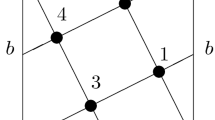Abstract
In this paper we construct two classes of binary quantum error-correcting codes on closed orientable surfaces. These codes are derived from self-dual orientable embeddings of complete bipartite graphs and complete multipartite graphs on the corresponding closed orientable surfaces. We also show a table comparing the rate of these quantum codes when fixing the minimum distance to 3 and 4.


Similar content being viewed by others
References
Shor, P.W.: Scheme for reducing decoherence in quantum memory. Phys. Rev. A 2, 2493–2496 (1995)
Calderbank, A.R., Rains, E., Shor, P.W., Sloane, N.: Quantum error correction via codes over GF(4). IEEE Trans. Inf. Theory 44, 1369–1387 (1998)
Bombin, H., Martin-Delgado, M.A.: Optimal resources for topological two-dimensional stabilizer codes: Comparative study. Phys. Rev. A 76, 012305 (2007)
Kitaev, A.Y.: Fault-tolerant quantum computation by anyons. Ann. Phys. 303, 2–30 (2003)
Bombin, H., Martin-Delgado, M.A.: Topological quantum distillation. Phys. Rev. Lett. 97, 180501 (2006)
Leslie, M.: Hypermap-homology quantum codes. Int. J. Quantum Inf. 12, 1430001 (2014)
Bombin, H., Martin-Delgado, M.A.: Topological quantum error correction with optimal encoding rate. Phys. Rev. A 73, 062303 (2006)
de Albuquerque, C.D., Junior, R.P., da Silva, E.B.: Construction of new toric quantum codes. Contemporary Math. 518, 1–9 (2010)
de Albuquerque, C.D., Palazzo, R. Jr, da Silva, E.B.: Topological quantum codes on compact surfaces with genus g2. J. Math. Phys. 50, 023513 (2009)
de Albuquerque, C.D., Palazzo, R. Jr, da Silva, E.B.: New classes of topological quantum codes associated with self-dual, quasi self-dual and denser tessellations. Quantum Inf. Comput. 10, 956–970 (2010)
Yu, S., Bierbrauer, J., Dong, Y., Chen, Q., Oh, C.H.: All the stabilizer codes of distance 3. IEEE Trans. Inf. Theory 59, 5179–5185 (2013)
Nigg, D., Muller, M., Martinez, E.A., Schindler, P., Hennrich, M., Monz, T., Martin-Delgado, M.A., Blatt, R.: Quantum computations on a topologically encoded qubit. Science 345, 302–305 (2014)
Nakahara, M.: Geometry, Topology and Physics, 2nd edn. IOP Publishing Ltd, UK (2003)
Edelsbrunner, H., Harer, J.: Computational topology, Duke University (2008)
Ringel, G.: Map Color Theorem, Grundlehren Der Mathematischen Wissenschaften Bd. 209. Springer, New York (1974)
Archdeacon, D., Hartsfield, N.: Self-dual embeddings of complete bipartite graphs. J. Combin. Theory Ser. B 54, 249–256 (1992)
Zemor, G.: On Cayley graphs, surface codes, and the limits of homological coding for quantum error correction. In: Second International Workshop LNCS 5557, pp 259–273. Springer, Berlin (2009)
Stillwell, J.: Geometry of Surfaces. Springer, Berlin (2000)
Beardon, A.: The Geometry of Discrete Groups. Springer, New York (1983)
Vieira, V.L., Faria, M.B., Palazzo, R. Jr: Generalized edge-pairings for the family of hyperbolic tessellations {10λ, 2λ}. Comp. Appl. Math. 35, 29–43 (2016)
Derek, F.H., Bettina, E., Eamonn, A.O.: Handbook of computational group theory. Chapman and Hall/CRC, Boca Raton (2005)
Author information
Authors and Affiliations
Corresponding author
Additional information
Publisher’s Note
Springer Nature remains neutral with regard to jurisdictional claims in published maps and institutional affiliations.
Appendix
Appendix
In this Appendix, we give an object-oriented package in Matlab to compute minimum distance of quantum codes derived from self-dual orientable embeddings of Ks, s for s ≥ 4. After finding the matrices HX and HZ using the method of rotation scheme [15] for constructing orientable embeddings of Ks, s, we can then determine the minimum distance of the associated quantum code. The following algorithm comes from [21].

Rights and permissions
About this article
Cite this article
Naghipour, A. New classes of quantum codes on closed orientable surfaces. Cryptogr. Commun. 11, 999–1008 (2019). https://doi.org/10.1007/s12095-018-0347-9
Received:
Accepted:
Published:
Issue Date:
DOI: https://doi.org/10.1007/s12095-018-0347-9




